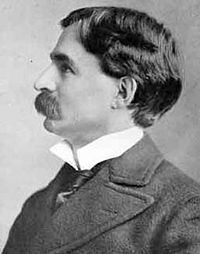Nationality American Fields Mathematics | Name E. Moore Role Mathematician | |
 | ||
Born January 26, 1862Marietta, Ohio, U.S. ( 1862-01-26 ) Institutions University of Chicago 1892–31Yale University 1887–89Northwestern University 1886–87, 1889–92 Doctoral students George BirkhoffLeonard DicksonT. H. HildebrandtD. N. LehmerRobert Lee MooreOswald VeblenAnna Wheeler Known for "General analysis",Moore–Smith convergence of nets in topology,Moore family and hull operator,Moore–Penrose inverse,Galois representation of finite fields,Axiomatic systems Notable awards AMS Colloquium Lecturer, 1906 Books General Analysis - Part 2: Th, The New Haven Colloquium, The New Haven Mathemat, General Analysis - Part 1: M Similar People Oswald Veblen, Robert Lee Moore, Leonard Eugene Dickson, George David Birkhoff, Anna Johnson Pell Whe | ||
Doctoral advisor Hubert Anson Newton | ||
Eliakim Hastings Moore (; January 26, 1862 – December 30, 1932), usually cited as E. H. Moore or E. Hastings Moore, was an American mathematician.
Contents
Life
Moore, the son of a Methodist minister and grandson of US Congressman Eliakim H. Moore, discovered mathematics through a summer job at the Cincinnati Observatory while in high school. He learned mathematics at Yale University, where he was a member of Skull and Bones and obtained a B.A. in 1883 and the Ph.D. in 1885 with a thesis, supervised by Hubert Anson Newton, on some work of William Kingdon Clifford and Arthur Cayley. Newton encouraged Moore to study in Germany, and thus he spent an academic year at the University of Berlin, attending lectures by Kronecker and Weierstrass.
On his return to the United States, Moore taught at Yale and at Northwestern University. When the University of Chicago opened its doors in 1892, Moore was the first head of its mathematics department, a position he retained until his death in 1931. His first two colleagues were Bolza and Maschke. The resulting department was the second research-oriented mathematics department in American history, after Johns Hopkins University.
Accomplishments
Moore first worked in abstract algebra, proving in 1893 the classification of the structure of finite fields (also called Galois fields). Around 1900, he began working on the foundations of geometry. He reformulated Hilbert's axioms for geometry so that points were the only primitive notion, thus turning Hilbert's primitive lines and planes into defined notions. In 1902, he further showed that one of Hilbert's axioms for geometry was redundant. Independently, during a course taught by G. B. Halsted, the twenty-year-old R.L. Moore (no relation) also proved this, but in a more elegant fashion than E. H. Moore used. When E. H. Moore heard of the feat, he arranged for a scholarship that would allow R.L. Moore to study for a doctorate at Chicago. E.H. Moore's work on axiom systems is considered one of the starting points for metamathematics and model theory. After 1906, he turned to the foundations of analysis. The concept of a closure operator first appeared in his 1910 Introduction to a form of general analysis. He also wrote on algebraic geometry, number theory, and integral equations.
At Chicago, Moore supervised 31 doctoral dissertations, including those of George Birkhoff, Leonard Dickson, Robert Lee Moore (no relation), and Oswald Veblen. Birkhoff and Veblen went on to lead departments at Harvard and Princeton, respectively. Dickson became the first great American algebraist and number theorist. Robert Moore founded American topology. According to the Mathematics Genealogy Project, as of December 2012, E. H. Moore had over 18,900 known "descendants."
Moore convinced the New York Mathematical Society to change its name to the American Mathematical Society, whose Chicago branch he led. He presided over the AMS, 1901–02, and edited the Transactions of the American Mathematical Society, 1899–1907. He was elected to the National Academy of Sciences, the American Academy of Arts and Sciences, and the American Philosophical Society. He was an Invited Speaker at the ICM in 1908 in Rome and in 1912 in Cambridge, England.
The American Mathematical Society established a prize in his honor in 2002.
